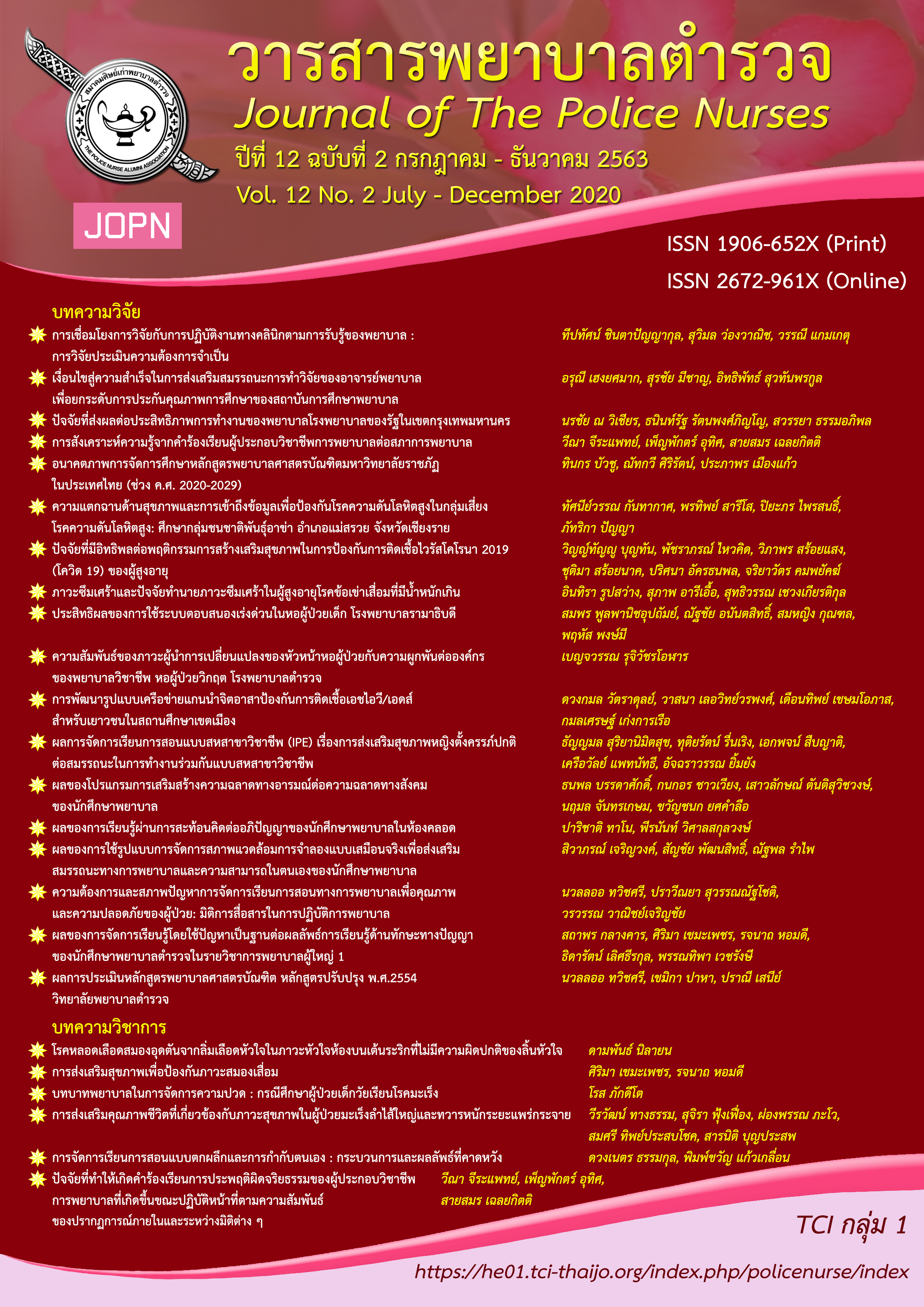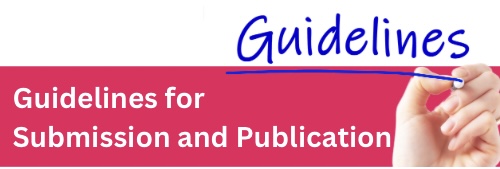FACTORS AFFECTING THE NURSE PERFORMANCE OF GOVERNMENT HOSPITAL NURSES IN BANGKOK
Keywords:
work performance, human capital development, ethical leadership, work passion, resilienceAbstract
This research aimed to develop and verify the validity of the performance model of the nurses at the ward government hospital in Bangkok. It was a mixed-method study. The research model was exploratory sequential design. The informant of the qualitative research was 12 heads or deputy heads of the inpatient and outpatient departments who gave in-depth interviews selected from a purposive selection. The sample in the quantitative research section consisted of 400 professional nurses. The samples were selected by stratified random sampling. The tool was an opinion questionnaire with 5 levels of confidence (reliability) in the topics of organizational culture, human capital development, ethical leadership, work passion, resilience and work performance. The Cronbach's alpha coefficients of the test were .890, .946, .929, .944, .930 and .945, respectively. The LISREL program was used to analyze the structure of the linear relationship and check the validity and consistency of the model created with the empirical data.
result of the research showed that the Linear Structure Relationship model of factors affecting the work performance of nurses in government sector hospitals in Bangkok was consistent with all empirical data (chi-square(df=2,n=398)=4.184, p=.123, GFI=.997, RMSEA=.052) and the internal latent variables were able to predict 65.20 % of the performance.
Downloads
References
Abdullah, I., Omar, R., & Rashid, Y. (2013). Effect of personality on organizational commitment and employees’ performance: Empirical evidence from banking sector of Pakistan. Middle-East Journal of Scientific Research, 17(6), 761-768.
Aburn, G., Gott, M., & Hoare, K. (2016). What is resilience? An integrative review of the empirical literature. Journal of Advanced Nursing, 72(5), 980-1000. http://doi.org/10.1111/jan.12888
Afrah, N. A. (2016). The role of human capital development on organizational performance: Case study. Benadir University, Mogadishu, 8(4), 120–124.
Appanna, K. K., & Avadhani, V. D. (2018). Impact of career resilience on job performance among the employes of private insurance sector. International Journal of Mechanical Engineering and Technology, 9(1), 423–430.
Armstrong, M. (2010). Armstrong’s essential human resource management practice: A guide to people management. Philadelphia, PA: Kogan Page.
Astakhova, M. N., & Porter, G. (2015). Understanding the work passion–performance relationship: The mediating role of organizational identification and moderating role of fit at work. Human Relations, 68(8), 1315–1346. https://doi.org/10.1177/0018726714555204
Awosusi, O. O., & Jegede, A.O. (2011). Motivation and job performances among nurses in the Ekiti State Environment of Nigeria. International Journal of Pharma and Bio Sciences, 2(2), 583–595.
Barkhordari-Sharifabad, M., Ashktorab, T., & Atashzadeh-Shoorideh, F. (2018). Ethical leadership outcomes in nursing: A qualitative study. Nursing Ethics, 25(8), 1051–1063. https://doi.org/10.1177/0969733016687157
Bass, B. M. (2008). The bass handbook of leadership: Theory, research, and managerial applications. New York, NY: Free Press.
Bogaert, P. V., Peremans, L., Heusden, D. V., Verspuy, M., Kureckova, V., Cruys, Z. V., & Franck, E. (2017). Predictors of burnout, work engagement and nurse reported job outcomes and quality of care: A mixed method study. BMC Nursing, 18, 1-14.
Bogdan, L., Mihelic, K., & Metka, T. 2010. Ethical leadership. International Journal of Management and Information System, 14(5), 31-41, http://doi.org/10.19030/ijmis.V14i5.11
Borman, W. C., & Motowidlo, S. J. (1999). Task performance and contextual performance: The meaning for personnel selection research. Human Performance, 10, 99-109.
Brown, M. E., Trevino, L. K., & Harrison, D. A. (2005). Ethical leadership: A social learning perspective for construct development and testing. Organizational Behavior and Human Decision Processes, 97, 117-134.
Campbell, K. N. (2017). History, passion, and performance. Workplace Health and Safety, 65(4), 164–167. https://doi.org/10.1177/2165079917700904
Charles A. O’Reilly, I. I. I., Caldwell, D. F., Chatman, J. A., & Doerr, B. (2014). The promise and problems of organizational culture: CEO personality, culture, and firm performance. Group & Organization Management, 39(6), 595–625. https://doi.org/10.1177/1059601114550713
Creswell, J. W. (2015). A concise introduction to mixed methods research. Thousand Oaks, CA: Sage.
Damrongsanti, C., & Bunsathorn, W. (2010). Importance and strengthening of love and driving force. Organizations in the creative economy era. Academic Research Conference 2010, Bangkok, National Institute of Development Administration.
Egan, R., Turner, M., & Blackman, D. (2017). Leadership and employee work passion: Propositions for future empirical investigations. Human Resource Development Review, 16(4), 394–424. https://doi.org/10.1177/1534484317724634
Fredrickson, B. L. (2004). The broaden-and-build theory of positive emotions. Philosophical Transactions of the Royal Society. Series B, Biological Sciences, 359, 1367-1378. http://doi.org/10.1098/rstb.2004.1512
Grotberg, E. H. (1995a). The international resilience project: research, application, and policy. Retrieved from http://doi.org/resilnet.uiuc.edu/library/grotb95a.
Grotberg, E. H. (1997). The international resilience project: Findings from the research and the effectiveness of interventions. Retrieved from http://doi.org/resilnet.uiuc.edu/library/grotb97a
Grotberg, E. H. (1998). I am, I have, I can: What family worldwide taught us about resilience. Reaching Today's Youth, 2(3), 36-39.
Hao, P., He, W., & Long, L.-R. (2017). Why and when empowering leadership has different effects on employee work performance: The pivotal roles of passion for work and role breadth self-efficacy. Journal of Leadership & Organizational Studies, 25(1), 85–100. https://doi.org/10.1177/1548051817707517
Hofstede, G. (2011). Dimensionalizing cultures: The Hofstede model in context. Online readings in psychology and culture, 2(1), 2307-0919.
Houlfort, N., Philippe, F. L., Vallerand, R. J., & Ménard, J. (2014). On passion and heavy work investment: Personal and organizational outcomes. Journal of Managerial Psychology, 29(1), 25–45. https://doi.org/10.1108/JMP-06-2013-0155
Huang, L., & Paterson, T. A. (2017). Group ethical voice: Influence of ethical leadership and impact on ethical performance. Journal of Management, 43(4), 1157–1184. https://doi.org/10.1177/0149206314546195
Jyoti, J., & Bhau, S. (2015). Impact of transformational leadership on job performance: Mediating role of leader–member exchange and relational identification. Sage Open, 5(4), 2158244015612518.
Kumari, P., & Sangwan, V. (2015). A Study on impact of resilience capacity on job performance of executives in the pharmaceutical industry. International Journal of Management and Social Sciences Research, 4(4), 2319-4421.
Lautongmeesakun, S. (2015). The structural equation model of teacher’s work passion: A comparative study of generation diversity (Doctor of Philosophy Thesis of Industrial and Organization Psychology). Faculty of Liberal Arts, King Mongkut's University of Technology North Bangkok, Bangkok.
Lee, Y. Y. (2016). Development of a performance appraisal tool for postoperative anesthesia care unit nurses. Journal of Korean Academy of Nursing Administration, 22(3), 270-278. http://doi.org/10.11111/jkana.2016.22.3.270
Marimuthu, M., Arokiasamy, L. & Ismail, M. (2009). Human capital development and its impact on firm performance: Evidence from developmental economics. The Journal of International Social Research, 2(8), 265-272.
Mondy, R. W., & Noe, R. M. (2005). Human resource management. New Jersey, NJ: Pearson Education.
Nair, R. (2006). Climate studies and associated best practices to improve climate issues in the workplace. 2006 WEPAN Conference, 1–8.
Nintachan, P., Sangon, S., & Thaweekoon, T. (2012) The effect of the resilience enhancing program in graduate nursing students. Journal of the Nursing Association of Thailand, 61(2), 18-27.
Oxford Dictionaries. (2015). Definition of resilience noun. Retrieved from https://www.oxfordlearnersdictionaries. com/definition/English/resilience
Robbins, S. P, & Judge, T. A. (2013). Organizational behavior (15th ed.). Prentice Hall.
Rosdi, I. S., & Harris, H. (2011). Human resource management practices and organizational commitment: The case of academics in a Malaysian Higher Education Institution. 2nd international conference on business and economic research (2nd ICBER 2011) proceeding, 1155–1173.
Serpa, S. (2016). An overview of the concept of organizational culture. International Business Management Journal, 10(1), 51-60.
Sikka, P. (2017). Using freedom of information laws to frustrate accountability: Two case studies of UK banking frauds. In Accounting Forum, 41(4), 300-317.
Srisatidnarakul, B. (2007). Leadership and strategic management in nursing organization for the 21st century. Bangkok: Chulalongkorn University Press.
Suksan, S. (2013). Project evaluation. Uttaradit: Uttaradit Rajabhat University.
Suvejwattanakun, C., & Kaewnuch, K. (2012). Alternatives Survival from the economic crisis of human capital activities in the tourism and service industry according to the sufficiency economy philosophy: Human capital management and development activities. National Academic Conference on the National Institute of Development Administration 2012.
The Ken Blanchard Companies. (2009a). Employee passion: The new rules of engagement. Retrieved from http://www.kenblanchard.com/getattachment/Leading-Research/Research/Employee-Passion-the-New-Rules-of-Engagement/Blanchard-Employee-Passion1.pdf
Tomic, B., Brkić, V. S., Karapetrovic, S., Pokrajac, S., Milanović, D. D., Babić, B., & Djurdjevic, T. (2017). Organizational culture, quality improvement tools and methodologies, and business performance of a supply chain. Proceedings of the Institution of Mechanical Engineers, Part B: Journal of Engineering Manufacture, 231(13), 2430–2442. https://doi.org/10.1177/0954405416629100
Vallerand, R. J., Paquet, Y., Philippe, F. L., & Charest, J. (2010). On the role of passion for work in burnout: A process model. Journal of Personality, 78(1), 289–312. http://doi.org/10.1111/j.1467-6494.2009.00616.x
Wisetsak, K. (2009). Research report on human capital development in the transition to modern organization or high-performance organization. Bangkok: Institute of Human Resources Thammasat University.
Downloads
Published
How to Cite
Issue
Section
License
ผลงานที่ได้ตีพิมพ์แล้วจะเป็นลิขสิทธิ์ของวารสารพยาบาลตำรวจ















